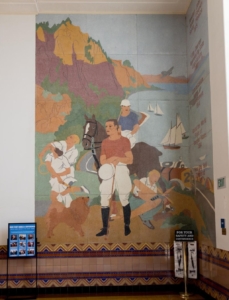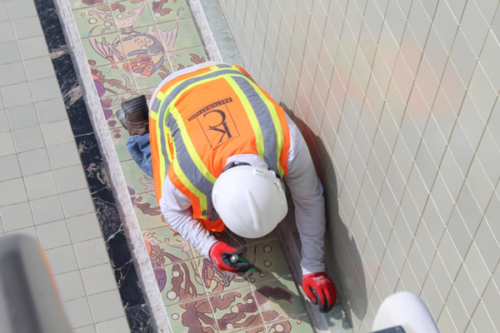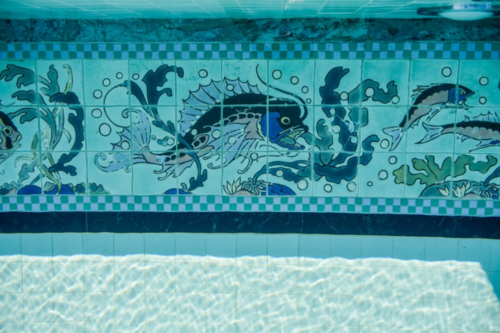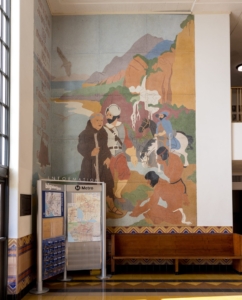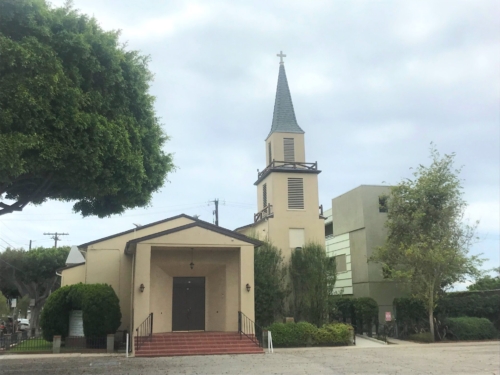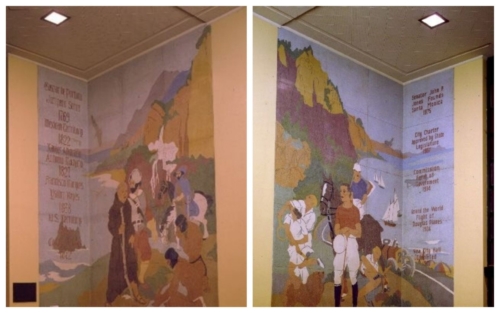City Hall Mural Update
by Ruthann Lehrer, Advocacy Committee Co-Chair
On September 28th, City Council moved forward on assigning the Landmarks Commission the responsibility of interpreting and contextualizing the City Hall murals, supported by an ad hoc Council committee consisting of Oscar De La Torre and Christine Parra. Their role is to advise the Landmarks Commission and to make recommendations, participating in the Commission discussions. De La Torre is interested in issues of racial injustice while Parra is interested in interpretation and education. The Arts Commission will also be involved. Thanks to Councilmembers Himmelrich and De La Torre for initiating this positive step forward after meeting with a Santa Monica Conservancy representative.
While the content of the History mural panel in City Hall has been highly controversial (read our prior messages by clicking here), the companion mural that depicts recreation in Santa Monica has also been criticized. The images there appear to be elitist, upper class white people engaged in tennis, polo, aviation, auto races and sailing. (Click here for a 360-degree view of the murals.)
In order to understand why the artist, Stanton MacDonald-Wright, selected these images, it’s necessary to do research to try to find any statement that he made about that artwork. We found a transcribed oral interview with the artist at the Archives of American Art at the Smithsonian. Here is an excerpt in which MacDonald-Wright talks about the Recreation mural. Unfortunately, the interview does not discuss the History mural.
Betty Hoag: There are some details about the Santa Monica City Hall mural I want to ask you about . . . particularly the one where the polo-players are. Do you remember the man in polo jodhpurs standing in front, and then a man on a horse behind him with a mallet?
Stanton MacDonald-Wright: Yes, I remember.
BH: Did those have anything to do with Will Rogers and his polo field?
SM: Yes. And that airplane and the automobile are very distinctly related to Santa Monica. The biggest automobile road-races that they had in California at that time were held in Santa Monica . . . .
BH: On San Vicente Boulevard?
SM: I don’t remember whether they were there or whether they were on Wilshire Boulevard, I forget. Also the first airplane field, Rogers Field, was built and given to Santa Monica by the son-in-law of this fellow about whom I told you, Gorham; he is depicted there. Now the plane business was important then. The Douglas building is shown in the mural. Douglas was the first great airplane-builder in the United States. And the tennis players! Remember, the best tennis players, the world champions, were all developed in Santa Monica: May Sutton and the Ryan girls and May Sutton’s daughter and Tom Bundy (who was later her husband) played in the doubles, and so on. All the greatest tennis players. So all those were put in the mural for good reasons.
What we discover is that the artist selected recreational and spectator sports that were huge visitor attractions and which drew people to Santa Monica. The images were chosen in the spirit of boosterism, pride in recreational activities that made the City famous. MacDonald-Wright was a Santa Monica resident who was quite knowledgeable about the City’s history and attractions.
